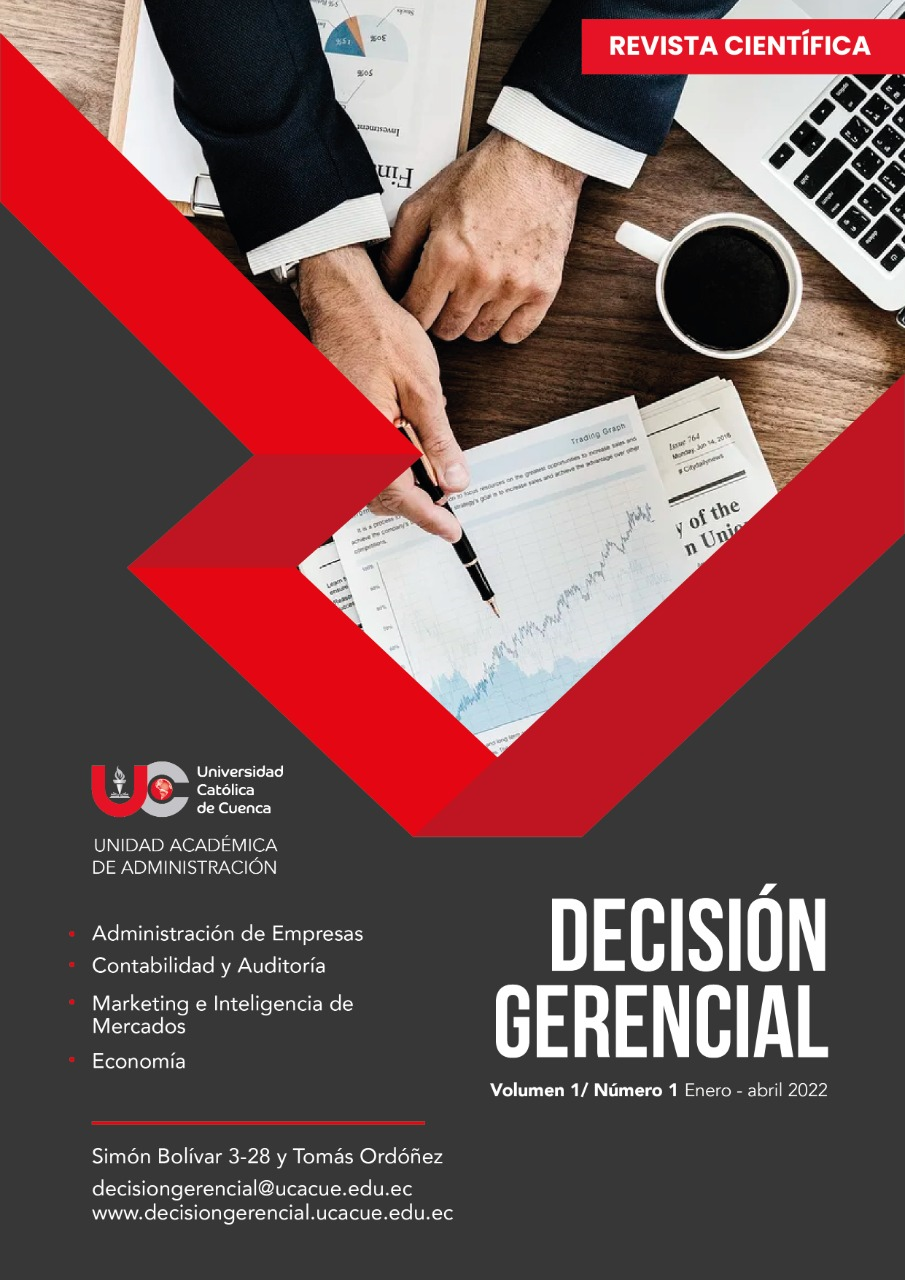THE EFFECT OF ADMINISTRATIVE AND FINANCIAL MANAGEMENT ON THE RESULTS OF CRAFT BREWERY COMPANIES, A CASE STUDY: NORDIC COMPANY
Main Article Content
Abstract
The purpose of the National Artisan Defense Board in Ecuador is to give benefits to artisans so that this sector can grow and prosper, in parallel to these companies they are considered within the group of SMEs, the same ones that adapt quickly to the market as well as to the needs of the client, therefore, they are the most important economic units for the generation
of employment within an emerging economy, in this context, the present research work focuses on the administrative and financial analysis of this commercial sector, taking information from the craft brewing company Nórdica Cia Ltda, the same
one that will be a reference for similar companies within the city of Cuenca; the methodology had a mixed approach, nonexperimental
and cross-sectional, where the qualitative began with the review of the literature on labor law, social security, socioeconomic reality, and the quantitative proceeded with the analysis of the financial economic information of one month, mathematical calculations were finally applied using the GeoGebra software, the descriptive method was also used to learn
about the company’s processes and procedures. As the most relevant results, it was determined that the artisanal brewing sector enjoys both tax and labor benefits, its current permanence depends a lot on using social networks to expand its market,
In terms of accounting, the analysis indicates that it is a profitable activity where the investment can be recovered in the first years, reinvest in raw materials to increase production and marketing, it was also determined that the best inventory control will be with the application of IAS 2 finally applying mathematical models such as the break-even point will influence proper decision-making.
Downloads
Article Details

This work is licensed under a Creative Commons Attribution-NonCommercial-NoDerivatives 4.0 International License.
Esta obra está bajo licencia internacional Creative Commons Reconocimiento-NoComercial-SinObrasDerivadas 4.0.
El aviso de Copyright abajo expuesto aparecerá en la sección "Sobre Nosotros" de la revista y en cada metadato de los ítems publicados. Si bien corresponde a la revista determinar la naturaleza de su acuerdo de derecho de autor con los autores, el Proyecto de Conocimiento Público (PKP) recomienda el uso de la licenciaCreative Commons. A tal fín,se proporciona el ejemplo de aviso de Copyright que puede ser copiado y pegado en el espacio inferior para revistas que (a) ofrezcan acceso abierto, (b) ofrezcan acceso abierto retardado, o (c) no ofrezcan acceso abierto.
References
Baque Pisco, V. (2015). Las artesanías ecuatorianas como patrimonio cultural; su aporte al desarrollo del turismo de la ciudad de Quito.
Bustos Flores, C. (2009). La producción artesanal. Mérida.
Código de Trabajo . (2012). Código de Trabajo.
Donoso Sánchez, A. (13 de 09 de 2017). Normas internacionales de Información Financiera (NIIF) – IFRS. Economipedia.com. Obtenido de Normas internacionales de Información Financiera (NIIF) – IFRS. Economipedia.com: https://economipedia.com/definiciones/normas-internacionales-informacion-financiera-niif-ifrs.html#referencia
DSG Consulting INTEGRAMOS SOLUCIONES. (09 de 01 de 2019). Características de las MiPymes en Ecuador. Obtenido de https://www.dsg.ec/gestion-empresas/mipymes-en-ecuador/
Fierro Martínez, A., & Fierro Celis, F. (2015). Contabilidad General con enfoque NIIF para pymes. En Contabilidad General con enfoque NIIF para pymes. Bogotá: Ecoe Ediciones Ltda.
Haeussler, E., & Paul, R. (2003). Matemáticas para administración y economía. México: PEARSON EDUCACIÓN.
Haeussler, E., Paul, R., & Wood, R. (2015). Matemáticas para la administración y la economía. En E. Haeussler, R. Paul, & R. Wood, Matemáticas para la administración y la economía. México: PEARSON.
Instituto Nacional de Estadística y Censos . (2017). Instituto Nacional de Estadística y Censos .
Instituto Nacional de Estadísticas y Censos . (2013). Instituto Nacional de Estadísticas y Censos .
Ley de Defensa del Artesano. (2008). Ley de Defensa del Artesano.
Ley de Seguridad Social. (2011). Ley de Seguridad Social.
Macías Collahuazo, E. (2018). La calificación artesanal otorgada por la Junta Nacional de Defensa del Artesano y su incidencia en el desarrollo socio-económico en el Ecuador. Lima.
Muñoz Jimenez, J. (2008). En Contabilidad Financiera. Madrid: PEARSON EDUCACIÓN, S. A.
Paralelo. (12 de octubre de 2019). El Debut Del Culto Artesanal. Obtenido de El Debut Del Culto Artesanal: https://www.paralelo.info/modernidad-liquida
Peñaherrera Bunce, A. (2013). ESTUDIO DE MERCADO Y ANÁLISIS FINANCIERO PARA LA CREACIÓN DE UNA EMPRESA PRODUCTORA DE CERVEZA ARTESANAL EN EL DISTRITO METROPOLITANO DE QUITO, CON ÉNFASIS EN EL USO DE LA MARCA DE LA PRIMERA CERVECERÍA CREADA EN AMÉRICA. Quito.
Pereira Morales, C., Maycotte Morales, C., Restrepo, B., Mauro, F., Calle Montes, A., Esther Velarde, M., . . . Portela Guarín, H. (2011). Economía 1. Caldas: Espacio Gráfico Comunicaciones S.A.
Plaza Mancera, R., & Villegas de Plaza, M. (2009). Contabilidad Social.
Rincón, L. (2019). Introducción a la Estadística Inferencial. México: Plaza Prometeo: tienda.fciencias.unam.mx.
Rodríguez Mendoza, R., & Aviles Sotomayor, V. (2020). Las PYMES en Ecuador. Un análisis necesario. Digital Publisher.
Rodríguez, D. (30 de 09 de 2015). Normas Internacionales de Contabilidad (NIC). Obtenido de Normas Internacionales de Contabilidad (NIC): https://contabilidad.com.do/normas-internacionales-de-contabilidad-nic/
Ron Amores, R., & Sacoto Castillo, V. (2017). Las Pymes Ecuatorianas: su impacto en el empleo como contribución del PIB PYMES al PIB total. Espacios.
Vásconez Jaramillo, P. (2014). Los Beneficios Artesanales, Causas y Consecuencias en el Derecho Laboral. Quito.
Zapata Sánchez, P. (2017). Contabilidad General. En P. Zapata Sánchez, Contabilidad General. Bogotá D.C.: Alfaomega Colombiana S.A.

